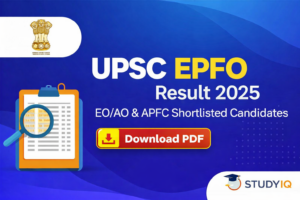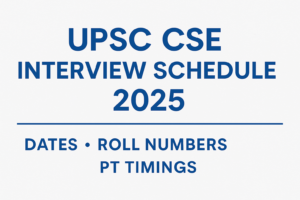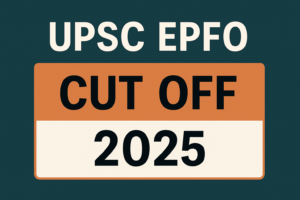The UPSC Prelims 2025 General Studies Paper 1 showcased a significant overlap with content published on the StudyIQ blog. Out of the total questions asked, several questions were directly or indirectly related to topics covered in StudyIQ’s comprehensive articles, underscoring the platform’s relevance and depth in UPSC preparation. These questions ranged across themes like electric vehicles, climate change, AI and quantum technologies, India’s freedom struggle, ancient history, and economic institutions, demonstrating the diverse and strategic coverage of the blog.
This alignment reinforces the fact that consistent reading and revision from credible and topic-specific sources like StudyIQ can substantially boost performance in competitive exams like UPSC. The blog’s analytical articles, updated current affairs insights, and focused study material match the evolving trend of UPSC asking conceptual, application-based, and contemporary questions. For aspirants, this is a clear indicator of the importance of aligning preparation strategies with trusted and updated educational platforms.
UPSC Prelims 2025 Asked Questions From StudyIQ (GS Paper 1 SET B)
Q3. In the context of electric vehicles, consider the following elements:
I. Cobalt
II. Graphite
III. Lithium
IV. Nickel
How many of the above usually make up battery cathodes?
(a) Only one
(b) Only two
(c) Only three
(d) All the four
Answer: (C)
Explanation:
Among the
- Typically cathode of lithium-ion batteries is composed of materials like lithium nickel manganese cobalt oxide or lithium iron phosphate.
- Graphite serves a primary anode in lithium-ion batteries, which power the vehicles. (Hence, Graphite is not included).
- Hence, among the above elements, Cobalt, Graphite and Lithium are included in Electric Cathodes.
Electric Vehicles and Battery Technologies, Functioning, Advantages
Q7. Consider the following statements:
I. It is expected that Majorana chip will enable quantum computing.
II. Majorana chip has been introduced by Amazon Web Services (AWS).
III. Deep learning is a subset of machine learning.
Which of the statements given above are correct?
(a) I and II only
(b) II and III only
(c) I and III only
(d) I, II and III
Answer: (C)
Explanation:
Statement I is correct. Microsoft introduced the Majorana 1 chip, which is based on a topological qubit architecture. This design aims to enhance the stability and scalability of quantum computers, potentially accelerating the development of practical quantum computing solutions.
Statement II is Incorrect. Majorana Chips introduced by Microsoft.
Statement III is Incorrect.
Topological Materials: The Future of Quantum Computing and Electronics
Q.12 Consider the following statements:
Statement I:
At the 28th United Nations Climate Change Conference (COP28), India refrained from signing the ‘Declaration on Climate and Health’.
Statement II:
The COP28 Declaration on Climate and Health is a binding declaration; and if signed, it becomes mandatory to decarbonize health sector.
Statement III:
If India’s health sector is decarbonized, the resilience of its health-care system may be compromised.
Which one of the following is correct in respect of the above statements?
(a) Both Statement II and Statement III are correct and both of them explain Statement I
(b) Both Statement II and Statement III are correct but only one of them explains Statement I
(c) Only one of the Statements II and III is correct and that explains Statement I
(d) Neither Statement II nor Statement III is correct
Answer: C
Explanation:
- At COP28, India chose not to sign the “Declaration on Climate and Health”. This decision was primarily due to concerns about the practicality and feasibility of reducing greenhouse gas emissions within the healthcare sector, particularly regarding the need for cold storage for vaccines and medicines
- Statement 2 is incorrect: The COP28 Declaration on Climate and Health is not a legally binding document; it’s a voluntary, non-binding political declaration. While it encourages countries to reduce greenhouse gas emissions in the health sector, signing the declaration doesn’t make decarbonization.
- Statement 3 is correct: India’s primary reason for not signing greenhouse gas reduction for cooling in the health sector could hinder its ability to meet the growing demands for medical services, particularly in remote and underserved areas. (According to Livemint report).
Editorial of the Day (19 Dec): What does COP-28 mean for cities?
Editorial of the Day (15 Dec): COP28 — Many a Slippery Slope Ahead
Q.13 Consider the following statements:
Statement I:
Scientific studies suggest that a shift is taking place in the Earth’s rotation and axis.
Statement II:
Solar flares and associated coronal mass ejections bombarded the Earth’s outermost atmosphere with a tremendous amount of energy.
Statement III:
As the Earth’s polar ice melts, the water tends to move towards the equator.
Which one of the following is correct in respect of the above statements?
(a) Both Statement II and Statement III are correct and both of them explain Statement I
(b) Both Statement II and Statement III are correct but only one of them explains Statement I
(c) Only one of the Statements II and III is correct and that explains Statement I
(d) Neither Statement II nor Statement III is correct
Answer: (B)
Explanation:
- Statement is correct: Recent studies confirm that the Earth’s axis is drifting, a phenomenon known as polar wander. The distribution of mass on Earth—especially due to climate-related changes—can influence the rotational axis of the Earth.
- Statement 2 is correct: Solar flares and CMEs (Coronal Mass Ejections) do release massive energy that impacts Earth’s magnetosphere, causing geomagnetic storms, auroras, and can affect satellite operations and communication. However, they do not directly affect Earth’s rotation or axial tilt.
- Statement 3 is correct and explains statement 1: Melting polar ice leads to redistribution of mass (water) from the poles toward the equator. This mass redistribution can influence the Earth’s moment of inertia, leading to a shift in its rotational axis.
Solar Flares: NASA Warns of Solar Storms, Blackouts and Auroras expected on Earth
Q.14 Consider the following statements:
Statement I:
Article 6 of the Paris Agreement on climate change is frequently discussed in global discussions on sustainable development and climate change.
Statement II:
Article 6 of the Paris Agreement on climate change sets out the principles of carbon markets.
Statement III:
Article 6 of the Paris Agreement on climate change intends to promote inter-country non-market strategies to reach their climate targets.
Which one of the following is correct in respect of the above statements?
(a) Both Statement II and Statement III are correct and both of them explain Statement I
(b) Both Statement II and Statement III are correct but only one of them explains Statement I
(c) Only one of the Statements II and III is correct and that explains Statement I
(d) Neither Statement II nor Statement III is correct
Answer: (A)
Explanation:
Article 6 of the Paris Agreement is a critical component of the global effort to combat climate change, facilitating cooperation and the use of carbon markets to achieve Nationally Determined Contributions (NDCs). It enables countries to work together, leveraging international carbon credits and non-market approaches to reduce greenhouse gas emissions and achieve climate targets.
India’s Potential in Carbon Trade Market and 29th Conference of Parties (COP29)
Q.16 With reference to Direct Air Capture, an emerging technology, which of the following statements is/are correct?
I. It can be used as a way of carbon sequestration.
II. It can be a valuable approach for plastic production and in food processing.
III. In aviation, it can be a source of carbon for combining with hydrogen to create synthetic low-carbon fuel.
Select the correct answer using the code given below.
(a) I and II only
(b) III only
(c) I, II and III
(d) None of the above statements is correct
Answer: C
Explanation:
- Statement 1 is correct: Direct Air Capture (DAC) is a technology that extracts carbon dioxide(CO2) directly from the atmosphere using chemical or physical processes. This captured CO2 can then be stored underground, used for various industrial applications, or further processed.
- Statement 2 is correct: Captured carbon di oxide can be used as a feedstock for plastic industry and can also be used in food processing industry in processes such as beverage carbonation, food preservation etc.
- Statement 3 is correct: Carbon di oxide extracted from Direct Air Capture technology can be combined with hydrogen to create synthetic fuels like jet fuel. This process, often called Power-to-Liquid (PtL) or Power-to-Jet, offers a path towards decarbonizing aviation by producing fuels that are essentially carbon-neutral.
Issues Surrounding Carbon Capture and Storage, Application, Challenges
Q.18 Consider the following statements:
I. Carbon dioxide (CO₂) emissions in India are less than 0.5 t CO₂/ caipta.
II. In terms of CO₂ emissions from fuel combustion, India ranks second in Asia-Pacific region.
III. Electricity and heat producers are the largest sources of CO₂ emissions in India.
Which of the statements given above is/are correct?
(a) I and III only
(b) II only
(c) II and III only
(d) I, II and III
Answer: C
Explanation:
- Statement 1 is not correct: According to Worldometer, India’s per capita CO₂ emissions were 1.89 t CO₂/capita in 2022. While this is still relatively low compared to many developed nations, it’s significantly higher than 0.5 t CO₂/capita.
- Statement 2 is correct: India ranks second in the Asia-Pacific region in terms of CO₂ emissions from fuel combustion. China is the largest emitter in the region, followed by India. The International Energy Agency (IEA) data confirms this
- Statement 3 is correct: In India, the electricity and heat production sector is indeed a major source of CO₂ emissions. This sector, particularly coal-based thermal power plants, contributes significantly to the country’s overall emissions. In fact, the IEA – International Energy Agency reports that power generation is a major source of CO2 emissions globally, and in India, it’s a leading contributor due to the use of coal and other fossil fuels
Q. 21 Consider the following statements about Rajar Ram Mohan Roy:
I. He possessed great love and respect for the traditional philosophical systems of the East.
II. He desired his countrymen to accept the rational and scientific approach and the principle of human dignity and social equality of all men and women.
Which of the statements given above is/are correct?
(a) I only
(b) II only
(c) Both I and II
(d) Neither I nor II
Answer. C
Explanation:
Raja Ram Mohan Roy possessed great love and respect for the traditional philosophic systems of the East; but, at the same time, he believed that modern culture Would help regenerate the India Society
Statement 2 is correct: He advocated for a rational and scientific approach to life, promoting human dignity and equality for all, regardless of gender
Raja Ram Mohan Roy Biography: Father of the Indian Renaissance
Q.22 Consider the following subjects with regard to Non-Cooperation Programme:
I. Boycott of law-courts and foreign cloth
II. Observance of strict non-violence
III. Retention of titles and honours without using them in public
IV. Establishment of Panchayats for settling disputes
How many of the above were parts of Non-Cooperation Programme?
(a) Only one
(b) Only two
(c) Only three
(d) All the four
Answer C
Explanation:
Statement 4 is in correct:
Titles were not retained during the Non-cooperation Movement. In fact, renouncing titles was a key part of the movement’s program. Mahatma Gandhi himself renounced titles bestowed upon him by the British, and other leaders and individuals followed suit, surrendering honorary posts and titles.
Q.25 Fa-hien (Faxian), the Chinese pilgrim, traveled to India during the reign of:
(a) Samudragupta
(b) Chandragupta II
(c) Kumeragupta I
(d) Skandagupta
Answer B
Explanation:
Fa-Hien was a Chinese pilgrim who visited India during the reign of Chandragupta II on a religious mission. He traveled by foot from China to India and returned by sea route.
Q. 26 Who among the following led a successful military campaign against the kingdom of Srivijaya, the powerful maritime state, which ruled the Malay Peninsula, Sumatra, Java and the neighbouring islands?
(a) Amoghavarsha (Rashtrakuta)
(b) Prataparudra (Kakatiya)
(c) Rajendra I (Chola)
(d) Vishnuvardhana (Hoysala)
Answer C
Explanation:
In 1025 CE, the Chola Emperor Rajendra I launched naval invasions on Srivijaya in maritime Southeast Asia, leading to the fall of the Sailendra Dynasty of Srivijaya.
Chola Dynasty, Map, Founder, Rulers, Administration, Art & Architecture
Q.27 With reference to ancient India (600–322 BC), consider the following pairs:
Table
| Territorial region | River flowing in the region |
| I. Asmaka | Godavari |
| II. Kamboja | Vipas |
| III. Avanti | Mahanadi |
| IV. Kosala | Sarayu |
How many of the pairs given above are correctly matched?
(a) Only one
(b) Only two
(c) Only three
(d) All the four
Answer: B
Explanation:
Option 1 and 4 is correctly matched
Aśmaka or Assaka was a Mahajanapada in ancient India which existed between 700 BCE and 425 or 345 BCE according to the Buddhist texts and Puranas.
Kosala extended across both banks of the Sarayu (modern Ghaghara) River and north into what is now Nepal. According to the Hindu epic the Ramayana, Kosala was ruled by kings descended from the Sun; one of these kings was Rama, whose capital was Ayodhya (Oudh), near modern Faizabad.
Q.29 Ashokan inscriptions suggest that the ‘Pradeshika’, ‘Rajuka’ and ‘Yukta’ were important officers at the:
(a) village-level administration
(b) district-level administration
(c) provincial administration
(d) level of the central administration
Answer: B
Explanation:
Ashokan inscriptions indicate that the ‘Pradeshika’, ‘Rajuka’, and ‘Yukta’ were important officers at the district level. These officers were responsible for the administration, revenue collection, and accounting functions within the districts of the Mauryan Empire.
Mauryan Empire Map, History, Achievements, Kings, Wars, Decline
Q.30 Consider the following statements in respect of the Non-Cooperation Movement:
I. The Congress declared the attainment of ‘Swaraj’ by all legitimate and peaceful means to be its objective.
II. It was to be implemented in stages with civil disobedience and non-payment of taxes for the next stage only if ‘Swaraj’ did not come within a year and the Government resorted to repression.
Which of the statements given above is/are correct?
(a) I only
(b) II only
(c) Both I and II
(d) Neither I nor II
Answer: C
Explanation:
Statement 1 is Correct: C.R. Das moved the main resolution on Non-Cooperation in the annual session of Congress in Nagpur in 1920. In Nagpur session Congress decided to have the attainment of Swaraj through peaceful and legitimate means
Statement 2 is also Correct: The strategy described, implemented by the Congress, involved a phased approach to achieving “Swaraj” (self-rule). The initial stage involved non-cooperation, which included withdrawing voluntary association with the British government. If Swaraj wasn’t achieved within a year and the government responded with repression, the next stage would involve civil disobedience, including non-payment of taxes. This was a strategy to exert pressure on the British government through nonviolent means
Q.32 Which of the following are the sources of income for the Reserve Bank of India?
I. Buying and selling Government bonds
II. Buying and selling foreign currency
III. Pension fund management
IV. Lending to private companies
V. Printing and distributing currency notes
Select the correct answer using the code given below.
(a) I and II only
(b) II, III and IV
(c) I, III, IV and V
(d) I, II and V
Answer: A
Explanation:
- Foreign Currency Investments: RBI invests India’s forex reserves in dollars, euros, pounds, etc. It earns interest on these investments. Statement I is correct.
- Currency Trading: RBI buys and sells dollars to keep the value of the rupee stable. The profit from these transactions is RBI’s income.
- Interest on Domestic Assets: RBI holds government bonds and lends to banks at the repo rate. It earns interest from these activities. In 2023- 24, the repo rate was mostly at 6.5%, so earnings were good. Statement II is correct.
Q.33 With reference to the Government of India, consider the following information:
Table
| Organization | Some of its functions | It works under |
| I. Directorate of Enforcement | Enforcement of the Fugitive Economic Offenders Act, 2018 | Internal Security Division-I, Ministry of Home Affairs |
| II. Directorate of Revenue Intelligence | Enforces the Provisions of the Customs Act, 1962 | Department of Revenue, Ministry of Finance |
| III. Directorate General of Systems and Data Management | Carrying out big data analytics to assist tax officers for better policy and nabbing tax evaders | Department of Revenue, Ministry of Finance |
In how many of the above rows is the information correctly matched?
(a) Only one
(b) Only two
(c) All the three
(d) None
Answer: B
Explanation: I is Incorrect
Directorate of Enforcement (ED)
- Functions: Enforcement of the Fugitive Economic Offenders Act, 2018 – Correct, as the ED enforces this act along with PMLA and FEMA.
- Works Under: Internal Security Division-I, Ministry of Home Affairs – Incorrect. The ED operates under the Department of Revenue, Ministry of Finance, not the Ministry of Home Affairs.
Option II is correct.
Directorate of Revenue Intelligence (DRI)
- Functions: Enforces the provisions of the Customs Act, 1962 –as the DRI focuses on customs-related enforcement.
- Works Under: Department of Revenue, Ministry of Finance – as the DRI functions under the CBIC, which is part of the Department of Revenue.
Directorate General of Systems and Data Management (DG Systems)
- Functions: Carrying out big data analytics to assist tax officers for better policy and nabbing tax evaders – Correct, as DG Systems uses data analytics for tax administration.
- Works Under: Department of Revenue, Ministry of Finance (noted as CBIC) – Correct, as DG Systems is under the CBIC, part of the Department of Revenue.
Enforcement Directorate (ED), Power, Functions and Jurisdiction
Q.36 Consider the following statements:
I. India has joined the Minerals Security Partnership as a member.
II. India is a resource-rich country in all the 30 critical minerals that has identified.
III. The Parliament in 2023 has amended the Mines and Minerals (Development and Regulation) Act, 1957 empowering the Central Government to exclusively auction mining lease and composite license for certain critical minerals.
Which of the statements given above are correct?
(a) I and II only
(b) II and III only
(c) I and III only
(d) I, II and III
Answer: C
Explanation:
Statement 1 is correct: India joined the Minerals Security Partnership (MSP) in June 2023. The MSP is a U.S.-led initiative involving countries like the U.S., Australia, Canada, Japan, and others, aimed at securing stable and sustainable supply chains for critical minerals.
Statement 2 is incorrect: India is not resource-rich in all 30 critical minerals identified by the government. While India has reserves of some key minerals, it is heavily dependent on imports for others like lithium, cobalt, and nickel.
Statement 3 is correct: In 2023, the Mines and Minerals (Development and Regulation) Act, 1957 was amended. The amendments empowered the Central Government to: Exclusively auction mining leases and composite licenses for 24 critical and strategic minerals-viz. molybdenum, rhenium, tungsten, cadmium, indium, gallium, graphite, vanadium, tellurium, selenium, nickel, cobalt, tin, platinum group of elements, minerals of “rare earth” group (not containing Uranium and Thorium); fertilizer minerals such as potash, glauconite and phosphate (without uranium) and minerals being removed from the list of atomic minerals.
Q.38 Consider the following statements:
I. India accounts for a very large portion of all equity option contracts traded globally thus exhibiting a great boom.
II. India’s stock market has grown rapidly in the recent past even overtaking Hong Kong’s at some point of time.
III. There is no regulatory body either to warn the small investors about the risks of options trading or to act on unregistered financial advisors in this regard.
Which of the statements given above are correct?
(a) I and II only
(b) II and III only
(c) I and III only
(d) I, II and III
Answer: A
Explanation:
Statement I is correct: India has become a global leader in equity options trading. In 2023, Indian exchanges traded 85 billion options contracts, more than any other country, a trend that started in 2019 when India overtook the US in volume (though not in dollar value).
Statement II is correct: India’s stock market has seen rapid growth, with the market capitalization of listed companies reaching $3.989 trillion by November 2023, surpassing Hong Kong’s $3.984 trillion. By December 2023, India overtook Hong Kong to become the world’s seventh-largest stock market.
Statement III is Incorrect: India has a regulatory body, the Securities and Exchange Board of India (SEBI), which oversees the stock market, including options trading. SEBI has actively warned small investors about the risks of options trading.
Q.39 Consider the following statements:
Statement I:
Circular economy reduces the emissions of greenhouse gases.
Statement II:
Circular economy reduces the use of raw materials as inputs.
Statement III:
Circular economy reduces wastage in the production process.
Which one of the following is correct in respect of the above statements?
(a) Both Statement II and Statement III are correct and both of them explain Statement I
(b) Both Statement II and Statement III are correct but only one of them explains Statement I
(c) Only one of the Statements II and III is correct and that explains Statement I
(d) Neither Statement II nor Statement III is correct
Answer: A
Explanation:
A circular economy is an economic system aimed at minimizing waste and making the most of resources. Unlike the traditional linear economy (take-make-dispose), a circular economy focuses on reusing, repairing, refurbishing, and recycling materials to create a closed-loop system.
- Statement I is correct: By reusing and recycling materials, the need for extracting raw materials (e.g., mining, deforestation) decreases, which lowers emissions from these energy-intensive processes.
- Statement II is correct: A core principle of the circular economy is to keep materials in use for as long as possible. This is achieved through:
○ Reuse and Recycling: Materials are reused or recycled instead of extracting new raw materials.
- Statement III is correct: The circular economy minimizes waste by optimizing production processes and ensuring that byproducts are reused or repurposed:
○ Efficient Production: Companies adopt lean manufacturing to reduce material waste during production (e.g., using scraps from one process as inputs for another).
Q.40 Consider the following statements:
I. Capital receipts create a liability or cause a reduction in the assets of the Government.
II. Borrowings and disinvestment are capital receipts.
III. Interest received on loans creates a liability of the Government.
Which of the statements given above are correct?
(a) I and II only
(b) II and III only
(c) I and III only
(d) I, II and III
Answer: A
Explanation:
Statement I is correct: Capital receipts are funds received by the Government that either increase its liabilities (e.g., borrowings) or reduce its assets (e.g., disinvestment, where the Government sells its stake in public sector enterprises).
Statement II is correct: Borrowings (e.g., issuing Government securities or taking loans) and disinvestment (e.g., selling stakes in PSUs) are classified as capital receipts in India’s budget. Borrowings increase the Government’s liabilities, and disinvestment reduces its assets, fitting the definition of capital receipts as per the Ministry of Finance.
Statement III is Incorrect: Interest received on loans (e.g., loans given by the Government to states or PSUs) is a revenue receipt, not a capital receipt, as it does not create a liability or reduce assets. Instead, it increases the Government’s income.
Major Components of Union Budget, Key Concept and Significance
Q.41 Consider the following countries:
I. Austria
II. Bulgaria
III. Croatia
IV. Serbia
V. Sweden
VI. North Macedonia
How many of the above are members of the North Atlantic Treaty Organization?
(a) Only three
(b) Only four
(c) Only five
(d) All the six
Answer: B
Explanation:
About NATO
- Genesis: Founded in 1949, with the signing of the North Atlantic
- Treaty or Washington Treaty, with the aim of acting as a deterrent to the threat of Soviet expansion in Europe after World War II.
- Headquarters: Brussels (Belgium)
- It is founded on the principle of collective defence (Article 5 of the Treaty), meaning that if one NATO Ally is attacked, then all NATO Allies are attacked.
- So far, Article 5 has been invoked once – in response to the 9/11 terrorist attacks.
Sebia and Austria is not member of NATO
- Serbia is not a member of NATO because it has adopted a policy of military neutrality and does not aspire to join the alliance, despite being a partner in the Partnership for Peace (PfP) program.
- Austria is not a member of NATO primarily because of its constitutional commitment to neutrality, enshrined in the Austrian State Treaty in 1955. This neutrality prohibits Austria from joining any military alliance, hosting foreign military bases, or participating in a war. While Austria has engaged in various forms of cooperation with NATO, such as joining the NATO’s Partnership for Peace in 1995, its neutrality remains a key tenet of its foreign policy.
NATO Countries List 2025, Members, Functions and Significance
Q.42 Consider the following countries:
I. Bolivia
II. Brazil
III. Colombia
IV. Ecuador
V. Paraguay
VI. Venezuela
Andes mountains pass through how many of the above countries?
(a) Only two
(b) Only three
(c) Only four
(d) Only five
Answer: C
Explanation:
Andes are the longest continental mountain range in the world, forming a continuous highland along the western edge of South America. The Andes extend from south to north through seven South American countries: Argentina, Chile, Bolivia, Peru, Ecuador, Colombia, and Venezuela. It does not pass through Brazil and Paraguay.
Q.43 Consider the following water bodies:
I. Lake Tanganyika
II. Lake Tönlé Sap
III. Patos Lagoon
Through how many of them does the equator pass?
(a) Only one
(b) Only two
(c) All the three
(d) None
Answer: D
Explanation:
- Lake Tanganyika: It is located in Central Africa, bordered by Tanzania, the Democratic Republic of Congo (DRC), Burundi, and Zambia The Equator does not cross the Lake Tanganyika
- Lake Tönlé Sap: It is in the northwest of Cambodia. Belonging to the Mekong River system, Tonlé Sap is the largest freshwater lake in Southeast Asia. It is located north of the equator.
- Lagoa dos Patos: It is a coastal lagoon located in the state of Rio Grande do Sul, southern Brazil. It is located south of the equator.
Q.44 Consider the following statements about turmeric during the year 2022–23:
I. India is the largest producer and exporter of turmeric in the world.
II. More than 30 varieties of turmeric are grown in India.
III. Maharashtra, Telangana, Karnataka and Tamil Nadu are major turmeric producing states in India.
Which of the statements given above are correct?
(a) I and II only
(b) II and III only
(c) I and III only
(d) All the three
Answer: D
Explanation:
- Statement I is correct: India is the largest producer, consumer and exporter of turmeric in the world. In the year 2022-23, an area of 3.24 lakh ha was under turmeric cultivation in India with a production of 11.61 lakh tonnes (over 75% of global turmeric production).
- Statement II and III are correct: More than 30 varieties of Turmeric are grown in India and it is grown in over 20 states in the country. The largest producing states of Turmeric are Maharashtra, Telangana, Karnataka and Tamil Nadu.
Turmeric Farming in India, Growing Conditions and Medical Uses
Q.45 Which of the following are the evidence of the phenomenon of continental drift?
I. The belt of ancient rocks from Brazil coast matches with those from Western Africa.
II. The gold deposits of Ghana are derived from the Brazil plateau when the two continents lay side by side.
III. The Gondwana system of sediments from India is known to have its counterparts in six different landmasses of the Southern Hemisphere.
Select the correct answer using the code given below.
(a) I and III only
(b) I and II only
(c) I, II and III
(d) II and III only
Answer: C
Explanation:
- Statement 1 is correct: Geological formations on the east coast of South America (Brazil) and the west coast of Africa (Western Africa) match in rock type, age, and structure, providing strong evidence that these continents were once joined.
- Statement 2 is correct: The gold bearing veins are in Brazil and it is obvious that the gold deposits of Ghana are derived from the Brazil plateau when the two continents lay side by side.
- Statement 3 is correct: The Gondwana sediments found in India share striking similarities with those found in South America, Africa, Antarctica, Australia, and Madagascar, providing compelling evidence that these landmasses were once part of a larger supercontinent called Gondwana, also known as Gondwanaland.
Q.47 Consider the following statements:
Statement I:
In January, in the Northern Hemisphere, the isotherms bend equatorward while crossing the landmasses, and poleward while crossing the oceans.
Statement II:
In January, the air over the oceans is warmer than that over the landmasses in the Northern Hemisphere.
Which one of the following is correct in respect of the above statements?
(a) Both Statement I and Statement II are correct and Statement II explains Statement I
(b) Both Statement I and Statement II are correct but Statement II does not explain Statement I
(c) Statement I is correct but Statement II is not correct
(d) Statement I is not correct but Statement II is correct
Answer: A
Explanation:
- Statement 1 is correct: In January, it is winter in the Northern Hemisphere. Landmasses (e.g., Asia, North America) cool faster than oceans due to lower specific heat capacity. This makes air over land colder, and isotherms bend toward the equator over land. Over oceans, where temperatures remain relatively warmer, isotherms bend poleward.
- Statement 2 is correct: Oceans retain heat longer than land due to higher heat capacity. Therefore, in winter, oceanic air is warmer than the continental air.
Pressure Belts of Earth, Types, Diagram, Shifting of Pressure Belts
Q.48 Consider the following statements:
Statement I:
In the context of the effect of water on rocks, chalk is known as a very permeable rock whereas clay is known as quite an impermeable or least permeable rock.
Statement II:
Chalk is porous and hence can absorb water.
Statement III:
Clay is not at all porous.
Which one of the following is correct in respect of the above statements?
(a) Both Statement II and Statement III are correct and both of them explain Statement I
(b) Both Statement II and Statement III are correct but only one of them explains Statement I
(c) Only one of the Statements II and III is correct and that explains Statement I
(d) Neither Statements II nor Statements III is correct
Answer: C
Explanation:
- Statement 1 is correct: Chalk is a porous sedimentary rock, allowing water to pass through easily—hence permeable. Clay, on the other hand, is impermeable or least permeable.
- Statement 2 is correct: Chalk contains microscopic pores and can hold and transmit water.
- Statement 3 is incorrect: Clay is porous. However, it is made up of extremely fine particles, which create very small spaces between them.These small spaces make it difficult for water to move through the clay.
Different Types of Rocks, Igneous, Sedimentary & Metamorphic Rocks
Q.50 Consider the following statements about the Rashtriya Gokul Mission:
I. It is important for the upliftment of rural poor as majority of low producing indigenous animals are with small and marginal farmers and landless labourers.
II. It was initiated to promote indigenous cattle and buffalo rearing and conservation in a scientific and holistic manner.
Which of the statements given above is/are correct?
(a) I only
(b) II only
(c) Both I and II
(d) Neither I nor II
Answer: C
Explanation:
- Statement 1 is correct: Rashtriya Gokul Mission is crucial for upliftment of rural poor as more than 80% low producing indigenous animals are with small and marginal farmers and landless labourers.
- Statement 2 is correct: One of the objectives of the scheme is to promote indigenous cattle & buffalo rearing and conservation in a scientific and holistic manner.
Rashtriya Gokul Mission (RGM), Objectives and Key Initiatives
Q.51 Consider the following statements:
I. Panchayats at the intermediate level exist in all States.
II. To be eligible to be a Member of a Panchayat at the intermediate level, a person should attain the age of thirty years.
III. The Chief Minister of a State constitutes a commission to review the financial position of Panchayats at the intermediate levels and to make recommendations regarding the distribution of net proceeds of taxes and duties, leviable by the State, between the State and Panchayats at the intermediate level.
Which of the statements given above are not correct?
(a) I and II only
(b) II and III only
(c) I and III only
(d) I, II and III
Answer: D
Explanation:
- Statement 1 is incorrect: According to Article 243B of the Indian Constitution, Panchayats are organized at three levels:
○ Village level (Gram Panchayat)
○ Intermediate level (Block Panchayat)
○ District level (Zila Parishad)
○ However, states with populations less than 20 lakhs are not required to establish intermediate-level Panchayats. For example, Goa, Sikkim, and some northeastern states do not have intermediate-level Panchayats. (https://www.pib.gov.in/newsite/erelcontent.aspx?relid=64390)
- Statement 2 incorrect: as per Article 243F(1)(a), the minimum age to contest Panchayat elections is 21 years, not 30. There is no separate age requirement for the intermediate level.
- Statement 3 is incorrect: The State Finance Commission is constituted under Article 243-I, but it is appointed by the Governor, not the Chief Minister. It is tasked with reviewing the financial position of all Panchayats (at all levels) and recommending distribution of resources.
Panchayati Raj Institutions, Evolution, Significance and Challenges
Q.52. Consider the following statements in respect of BIMSTEC :
I. It is a regional organization consisting of seven member States till January 2025.
II. It came into existence with the signing of the Dhaka Declaration, 1999.
III. Bangladesh, India, Sri Lanka, Thailand and Nepal are founding member States of
BIMSTEC.
IV. In BIMSTEC, the subsector of ‘tourism’ is being led by India.
Which of the statements given above is/are correct?
(a) I and II
(b) II and III
(c) I and IV
(d) I only
Answer:(d)
Explanation
- Statement 1 is correct: BIMSTEC (Bay of Bengal Initiative for Multi-Sectoral Technical and Economic Cooperation) is a regional organization comprising of seven Member States (Bangladesh, Bhutan, India, Myanmar, Nepal, Sri Lanka, and Thailand).
- Statement 2 is incorrect: It was established on 06 June 1997 with the signing of the Bangkok Declaration.
- Statement 3 is incorrect: The Bangkok Declaration (1997) formally laid the foundation for the organization, as BIST-EC(Bangladesh, India, Sri Lanka, and Thailand Economic Cooperation). Nepal is not the funding member; it joined the grouping later in 2004.
- Statement 4 is incorrect: In BIMSTEC, the subsector of ‘tourism’ is being led by Nepal
BIMSTEC Countries 2025, Area of Cooperation, Significance and Challenges
Q54. GPS-Aided Geo Augmented Navigation (GAGAN) uses a system of ground stations to provide necessary augmentation. Which of the following statements is/are correct in respect of GAGAN?
I. It is designed to provide additional accuracy and integrity.
II. It will allow more uniform and high-quality air traffic management.
III. It will provide benefits only in aviation but not in other modes of transportation.
Select the correct answer using the code given below.
(a) I, II and III
(b) I and III only
(c) I only
(d) I, II and III
Answer: D
Explanation:
ISRO and Airports Authority of India (AAI) have implemented the GAGAN project as a Satellite Based Augmentation System for the Indian Airspace. The primary objective of GAGAN is to establish a certifiable satellite based augmentation system for safety-of-life applications. The functional performance and operational requirements of GAGAN shall be governed by the specifications as mentioned in the international standards.
Statement I is correct: The GAGAN is designed to provide the additional accuracy, availability, and integrity necessary to enable users to rely on GPS for all phases of flight, from en route through approach for all qualified airports within the GAGAN service volume.
Statement II is correct: GAGAN will also provide the capability for increased accuracy in position reporting, allowing for more uniform and high-quality Air Traffic Management (ATM).
Statement III is correct: GAGAN will provide benefits beyond aviation to all modes of transportation, including maritime, highways, railroads and public services such as defence services, security agencies, telecom industry and personal users of position location applications.
GAGAN (GPS Aided Geo Augmented Navigation), Objectives, Features and Importance
Q.57 Consider the following statements with regard to BRICS:
I. 16th BRICS Summit was held under the Chairship of Russia in Kazan.
II. Indonesia has become a full member of BRICS.
III. The theme of the 16th BRICS Summit was Strengthening Multiculturalism for Just Global Development and Security.
Which of the statements given above is/are correct?
(a) I and II
(b) II and III
(c) I and III
(d) I only
Answer: A
Explanation:
Statement 1 is correct: On October 22-24, 2024, the 16th BRICS Summit was held in Kazan under the chairmanship of the Russian Federation.
Statement 2 is correct: Indonesia has joined the BRICS group effective from January 2025.
|
BRICS |
| The BRICS is currently composed of eleven countries: its five original members – Brasil, China, India, Russia, and South Africa -, and six new members admitted in 2024-25 – Egypt, Ethiopia, Indonesia, Iran, Saudi Arabia, and the United Arab Emirates. |
Statement 3 is incorrect: The theme of the 16th BRICS Summit was: “Strengthening Multilateralism for Fair Global Development and Security.”
BRICS Summit 2024, Date, Host, Theme, Agenda and Significance
Q63. Consider the following space missions:
I. Axiom-4
II. SpaDeX
III. Gaganyaan
How many of the space missions given above are encouraged and support microgravity research?
(a) Only one
(b) Only two
(c) All the three
(d) None
Answer: C
Explanation:
- Axiom-4 is a private astronaut mission to the International Space Station (ISS), organized by Axiom Space.
○ This mission includes multiple microgravity experiments focusing on human health, biotechnology, and agriculture. - SpaDeX is an Indian Space Research Organisation (ISRO) mission aimed at demonstrating autonomous docking technology in orbit. In addition to its primary objective, the mission utilizes the PSLV’s fourth stage (POEM-4) to host various scientific experiments, including those related to microgravity.
- Gaganyaan will be placed in the Low Earth Orbit. It will enable the humans present to conduct many micro-gravity experiments.
ISRO’s SpaDeX Mission, Objectives, Phases and Future Implications
Gaganyaan Mission, Objectives, Launch Vehicle and Components
Q65. Artificial way of causing rainfall to reduce air pollution makes use of:
(a) silver iodide and potassium iodide
(b) silver nitrate and potassium iodide
(c) silver iodide and potassium nitrate
(d) silver nitrate and potassium chloride
Answer: A
Explanation:
Commonly Used Substances in Cloud Seeding:
- Silver Iodide (AgI): Silver iodide is widely used due to its structural similarity to ice crystals, which facilitates ice nucleation in supercooled clouds. Its application has been prevalent in various cloud seeding operations worldwide.
- Dry Ice (Solid Carbon Dioxide): Dry ice serves as an effective agent by cooling the surrounding air, promoting ice crystal formation within clouds.
- Potassium Iodide: Similar to silver iodide, potassium iodide acts as a nucleating agent, aiding in the formation of precipitation.
Artificial Rain in Delhi and Cloud Seeding, Advantages, Disadvantages
Q. 66 Consider the following statements with regard to pardoning—power of the President of India:
I. The exercise of this power by the President can be subject to limited judicial review.
II. The President can exercise this power without the advice of the Central Government.
Which of the statements given above is/are correct?
(a) I only
(b) II only
(c) Both I and II
(d) Neither I nor II
Answer: A
Explanation:
- Statement 1 is correct: Article 72 of the Constitution gives the President the power to grant pardons, reprieves, respites, or remissions of punishment. While this power appears discretionary, the Supreme Court has held that it is not absolute.
- Statement 2 is incorrect: Under Article 74(1) of the Constitution, the President must act in accordance with the advice of the Council of Ministers. This includes the use of pardoning powers under Article 72.
Q. 70 Which organization has enacted the Nature Restoration Law (NRL) to tackle climate change and biodiversity loss?
(a) The European Union
(b) The World Bank
(c) The Organization for Economic Cooperation and Development
(d) The Food and Agriculture Organization
Answer: A
Explanation:
The Nature Restoration Law (NRL) was enacted by the European Union (EU). It is a comprehensive law aimed at restoring degraded ecosystems and tackling climate change and biodiversity loss within the EU.
Q. 80 Consider the following statements about PM Surya Ghar Muft Bijli Yojana:
I. It targets installation of one crore solar rooftop panels in the residential sector.
II. The Ministry of New and Renewable Energy aims to impart training on installation, operation, maintenance and repairs of solar rooftop systems at grassroot levels.
III. It aims to create more than three lakhs skilled manpower through fresh skilling, and upskilling, under scheme component of capacity building.
Which of the statements given above are correct?
(a) I and II only
(b) I and III only
(c) II and III only
(d) I, II and III
Answer: D
Explanation:
- Statement 1 is correct: The PM Surya Ghar: Muft Bijli Yojana, the world’s largest domestic rooftop solar initiative, aims to supply solar power to one crore households by March 2027.
- Statement 2 is correct: The Ministry of New and Renewable Energy (MNRE) intends to impart training on installation, operation, maintenance and repairing of solar roof top systems at grass root level.
- Statement 3 is correct: The scheme seeks to create more than 3 lakh skilled manpower, through fresh skilling, and up-skilling, under scheme component of capacity building, out of which at least 1,00,000 will be Solar PV Technicians
Q.93 Who provided legal defence to the people arrested in the aftermath of Chauri Chaura incident?
(a) C. R. Das
(b) Madan Mohan Malaviya
(c) Dr. Saifuddin Kitchlew and Khwaja Hasan Nizami
(d) M. A. Jinnah
Answer: B
Explanation:
Madan Mohan Malvia appeared in the High Court in 1923 after an interval of ten years, it was to support the appeal of the 170 persons sentenced to death by the Session judge of Gorakhpur in the Chauri Chaura case. In this case 225 persons had been tried for setting fire to the police station of Chauri Chaura (in Deoria district) and causing the death of one Sub-Inspector and 21 constables trapped in it. One hundred and seventy had been sentenced to death by the session judge. A barrister from Aligarh named Qadri was crown counsel. Malaviya argued the case in general for all the accused for four or five days. A dozen other lawyers appeared for individual accused persons. The case was heard by a bench consisting of Chief Justice Sir Grimwood Mears and Justice Sir Theodore Piggot.
Q.94 Subsequent to which one of the following events, Gandhiji, who consistently opposed untouchability and appealed for its eradication from all spheres, decided to include the upliftment of ‘Harijans’ in his political and social programme?
(a) The Poona Pact
(b) The Gandhi-Irwin Agreement (Delhi Pact)
(c) Arrest of Congress leadership at the time of the Quit India Movement
(d) Promulgation of the Government of India Act, 1935
Answer: A
Explanation:
After the Poona Pact was signed, Gandhi emphasized social reform and upliftment of the Dalits, whom he called “Harijans” (meaning “Children of God”).
Poona Pact History, Provision, Significance, Impact & Limitations
Q.98 Who among the following was the founder of the Self-Respect Movement?
(a) Periyar E. V. Ramaswamy Naicker
(b) Dr. B. R. Ambedkar
(c) Bhaskarrao Jadhav
(d) Dinkarrao Javalkar
Answer: A
Explanation:
The self-respect movement was founded by E.V. Ramaswamy Naicker, commonly known as Periyar. It was a dynamic social movement aimed at destroying the contemporary Hindu social order in its totality and creating a new, rational society without caste, religion and god.
Self Respect Movement, History, Objective, Significance & Important Aspects


 UPSC EPFO Result 2025 Out: EO/AO and APF...
UPSC EPFO Result 2025 Out: EO/AO and APF...
 UPSC CSE Interview Schedule 2025: Dates,...
UPSC CSE Interview Schedule 2025: Dates,...
 UPSC EPFO Cut Off 2025 (Expected): Categ...
UPSC EPFO Cut Off 2025 (Expected): Categ...

























